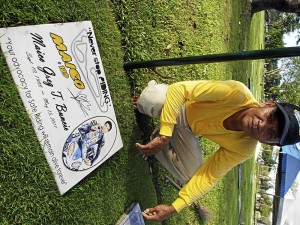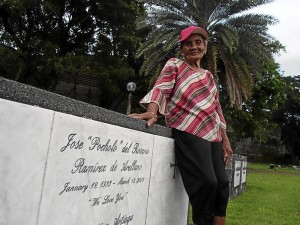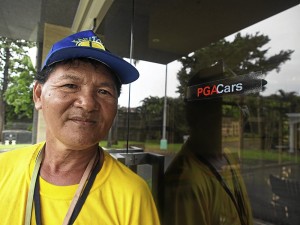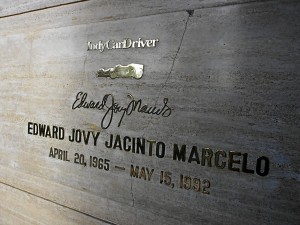Here lie the racing legends, quiet and still

TO THE end, superbike champ Maico espouses safety on two wheels. Boy Atacador makes sure the message remains clean and clear.
In life, as it is in a race, there’s a beginning and an end. The adulation for racing champions, and the stories of their triumphs and travails never end. Indeed, their legacy lives on. But when the very vessel of their flaming spirit expires, as all mortals eventually have to, their worldly remains will have to be laid to rest in a place far removed from the frenetic, noisy environment they lived and thrived in.
And when that happens, they do not necessarily have to spend eternity without some company looking after them from time to time.
We call them caretakers, but if the dead could speak, they might as well call them their caregivers. They make a living taking care of the dead, and they have grown used to the sight of cold concrete enclosing the remains not just of the dead, but of memories sweet or bitter. The caretakers do their rounds of the crypts every day, rain or shine. There are no noisy crowds, no deafening cheers, no cameras or fanfare. There’s only the chirping of the birds, the cool breeze, and the rustle of leaves being swept into a clump. The caretakers, by virtue of the length of their service, have become members of the extended family of the deceased. And in a Christian society that values its dead, and holds their final resting grounds sacred, the caretakers do hold that invaluable task of keeping the gravesites clean.
Inquirer Motoring visited the graves of the country’s racing legends, and was met by their caretakers like hosts welcoming visitors to a home.
Filipino motorcycle racer and four-time national superbike champion Maico Greg T. Buncio’s tombstone in Loyola Memorial Park in Marikina bears a picture of the racer wearing a suit and riding a motorbike. On top of his name is the slogan: “Never stop riding.” Below his name is written: “Your advocacy for safe riding will remain alive forever.” Maico died in a racing mishap in Clark, Pampanga on May 15, 2011. He was just 22.
Article continues after this advertisementMaico’s caretaker Boy Atacador, 52, recalled that he had seen Maico as a young boy when he visited the graves of his grandfather and other relatives on the same plot where Maico now lies. “He was very simple, and smiled a lot. (His death) was just so regrettable. I was deeply affected when I learned about it. My son also drives a motorbike,” Boy uttered in Filipino.
Article continues after this advertisementBoy learned about the accident through Maico’s father. The Buncio family, Boy said, have been helpful and generous. The caretaker said he was impressed by the sight of motorbike riders and big bikers paying their respects at Maico’s grave.
Search for Jovy

THE SLOW and easy takes care of the fast and furious. 81-year-old Resurecion Eblamo has time on her hands, and Tito Poch in her mind.
A search for Indy car driver Jovy Marcelo’s mausoleum location at the Loyola Memorial Park Marikina main office turns up the name “Indianapolis” in the computer. And it was in the Indianapolis Speedway where the 26-year-old budding racer would meet his violent end, during a practice run on May 15, 1992. “He was real soft-spoken. But in the car he was not afraid to race you hard, wheel-to-wheel. I think of a young Paul Tracy—Jovy was the same way,” quipped American race car driver Jimmy Vasser, then the Indy Car Series team owner.
A Speed online article by Marshall Pruett described him on a May 15, 2012, article: “The pie-faced Filipino wore a permanent smile, was a devout family man and was a star on the rise in open-wheel racing, but was largely anonymous at the time of his death 20 years ago today at Indianapolis.”
The marble-plated Marcelo memorial estate is just among a handful of mausoleums that can be found in Loyola Marikina.
Caretaker Jhun Salansan said that he saw the young Jovy when he visited the tomb of his other family members.
Jovy belonged to a family of car racers. “He was very young when he set foot here to visit his his Lolo. We didn’t know he was a big-time name in racing. We knew he was a sportsman, but we didn’t know it was in motorsports, until he died,” Jhun narrated.
Salansan proudly points out the gold-plated Indy Car logo above Jovy’s name, revealing that it may be the only tombstone in the country that bears the logo.
As easy as it was to locate the Marcelo gravesite, it took two trips to the Manila Memorial Park Parañaque locator office, and a tomb-by-tomb inspection of a section of the cemetery, to finally chance upon the tomb of Pocholo “Tito Poch” Ramirez. No wonder, his tombstone was inscribed with the name Jose Pocholo del Rosario Ramirez de Arellano.
It was a bit easier to find the caretaker, 81-year-old Resurecion Eblamo. One just has to follow the slow stroke of the walis tingting.

BERNIE Ferrer keeps his mausoleum as spiffy as the sportscars that visit it every now and then. Photos by Tessa R. Salazar
“Mabait yan si Daddy (Daddy was kind)”, she said, pointing to Tito Poch’s gravesite. “Galante magbigay. Hindi kuripot (very generous, never stingy)” she laughed.
She had been taking care of the Ramirez plot (where the remains of other loved ones were interred) even before Martial Law. When Pocholo was still alive, he regularly visited the Ramirez family plot.
Tito Poch was born in 1932, and died March 18, 2009. He was a legend among legends, earning driver of the year awards six times. In 2000, he was the Blaze Super Saloon Champion at the age of 68. Even after being diagnosed with urinary bladder cancer two and a half years before his death, he still competed in local races. Up until he was 75, Ramirez could still be seen behind the wheel competing with racers less than half his age.
‘Jedi master of driving’
He connected to the younger generation when, in 2005, he appeared in the TV commercial Petron Xtra Mile Challenge fuel economy run, where he confidently uttered the famous “Traffic? Bring it on!” Widely considered the “Jedi Master of driving,” Ramirez was admired for his smooth racing techniques. He started racing professionally at the age of 30, and his racing career spanned 45 years, with successful stints in Macau, Singapore, Malaysia, and Indonesia. He was honored in the 2008 Car of the Year Awards with a lifetime achievement award. A concert “I Heart Ramirez” was organized by motoring journalists late December 2008 in his honor.
Inquirer Motoring had also researched the location of the tomb of champion race car driver Arsenio Dodjie Laurel. His remains, it turned out, was cremated 10 years ago, and his ashes are now at the San Antonio crypt, according to a source who is a friend of the Laurels.
A lawyer by profession, Dodjie was the son of President Jose P. Laurel. He became a two-time champion at the Macau Grand Prix. It was in the 1967 race when his car spun out of control, crashed into the sea wall and burst into flames. He died at the age of 35.
A ‘showroom’ of a mausoleum
At a private cemetery south of Metro Manila, a mausoleum with several PGA Cars stickers posted on its glass walls drew Inquirer Motoring in.
Upon a little prodding, the caretaker finally revealed that the mausoleum belonged to the Coyiuto clan, the big bosses of PGA Cars.
Bernie Ferrer, 56, said he had been the caretaker of the tombs of parents of PGA Cars owner Robert Coyuito Jr. He recalled that most members of the Coyiuto family would come in flashy cars whenever they would visit the tombs.
Thus, on All Souls’ Day, the Coyiuto mausoleum would become a veritable showroom as Audi, Porsche, and even Lamborghini sports cars would park right in front, providing Bernie and his fellow caretakers hours of eye-candy entertainment.
“Kapag nagipit ako, sila ang takbuhan ko. Pag tuition, hindi sila maka hindi. Mabait sa trabahador (Whenever I run out of money for my kids’ tuition, the Coyuitos never say no. They are good to their staff),” attested Bernie.
“They were able to help my five children finish college. One of my daughters was even running for magna cum laude. When the Coyuitos learned about it, they were happy.”
Bernie said all of his children are now successful and have asked him to stop working, a suggestion he politely refused, insisting that taking care of tombs were his own way of repaying the kindness of the families that held these memorial shrines close to their hearts.
